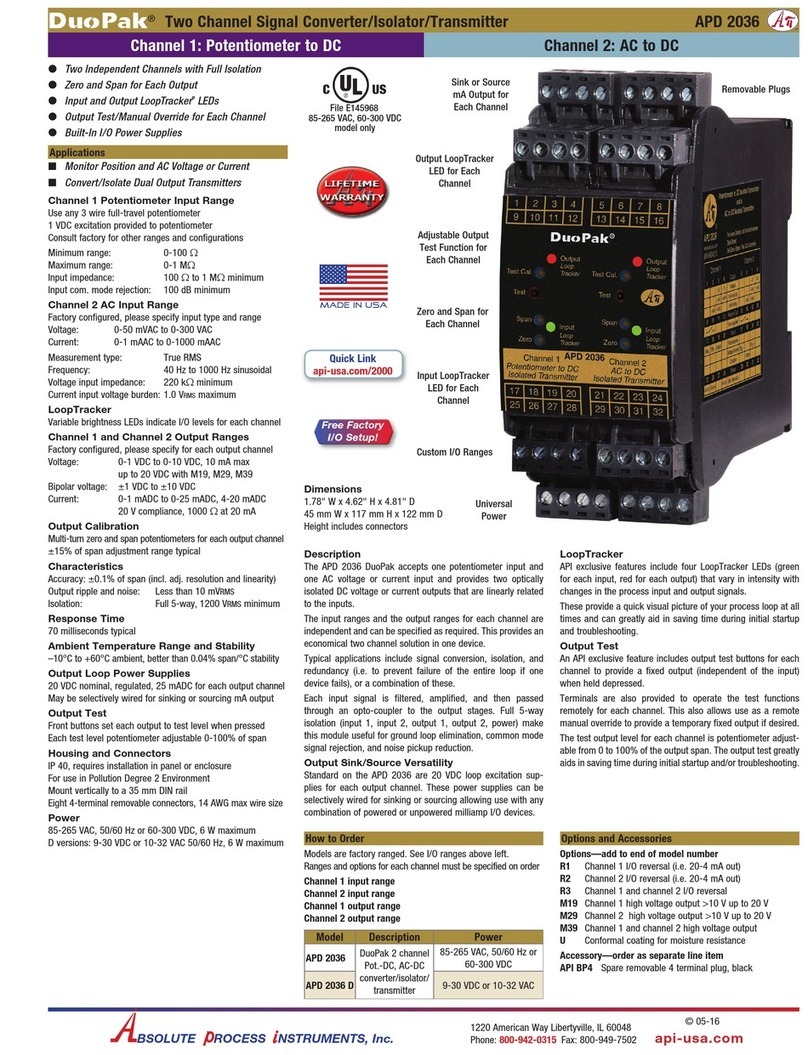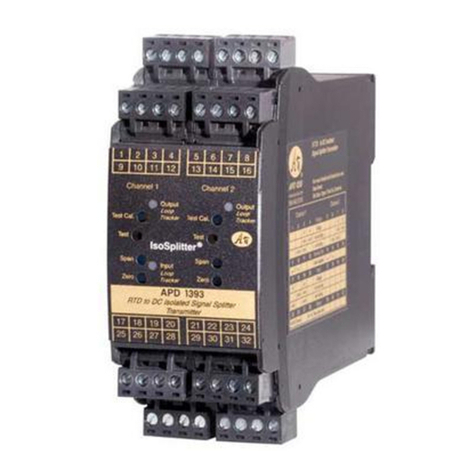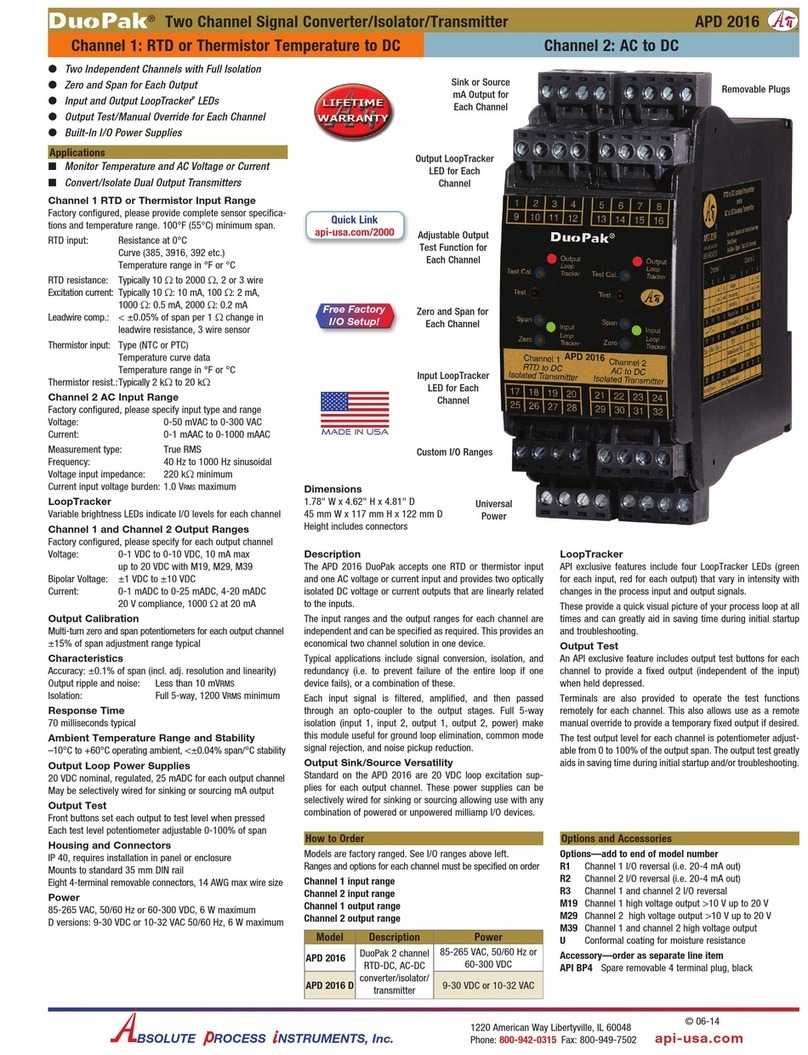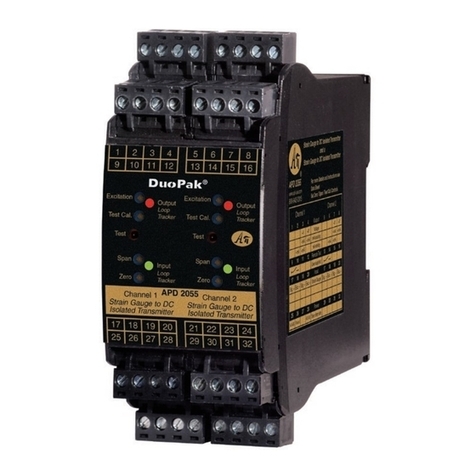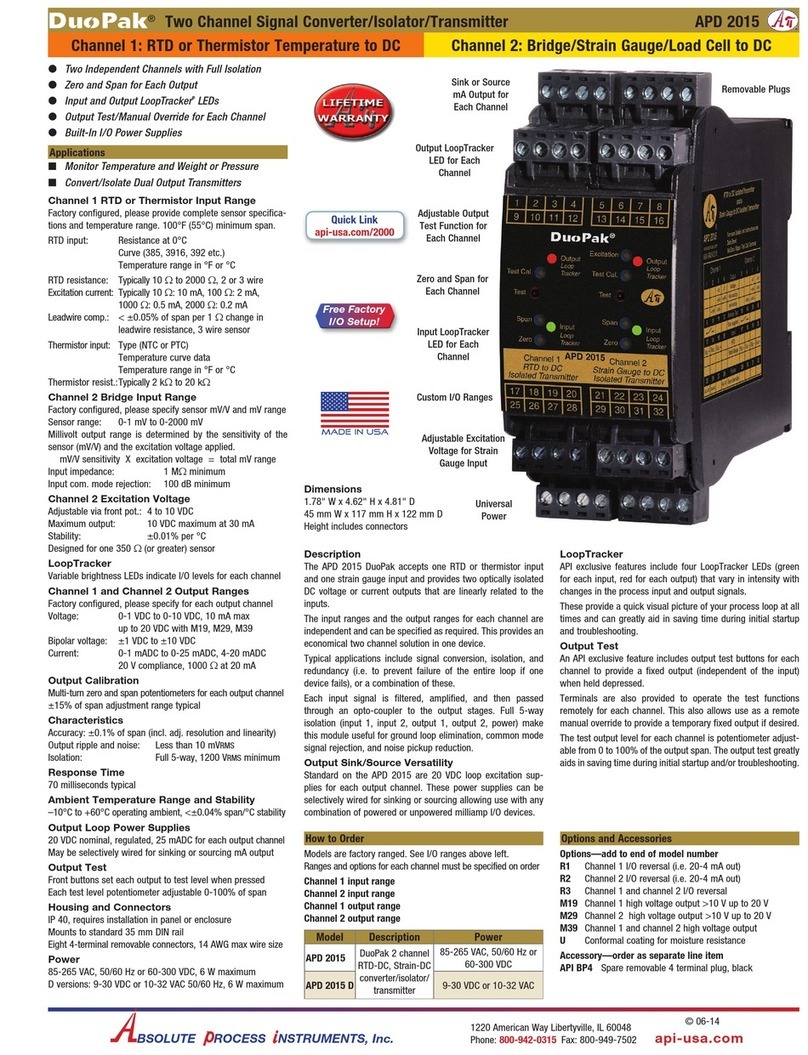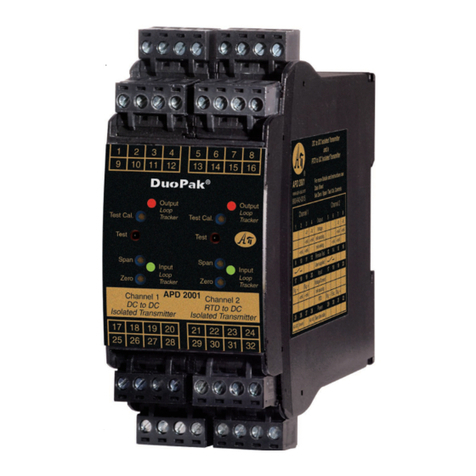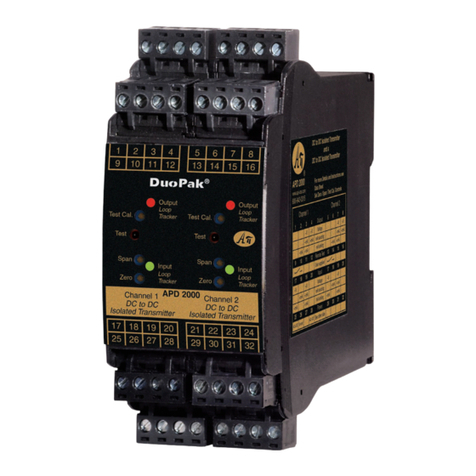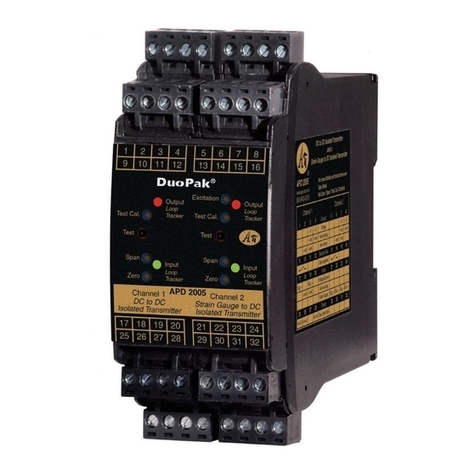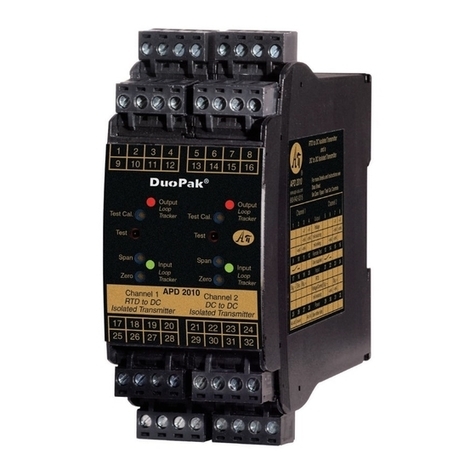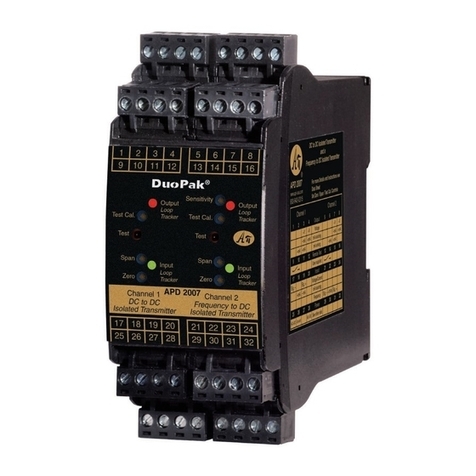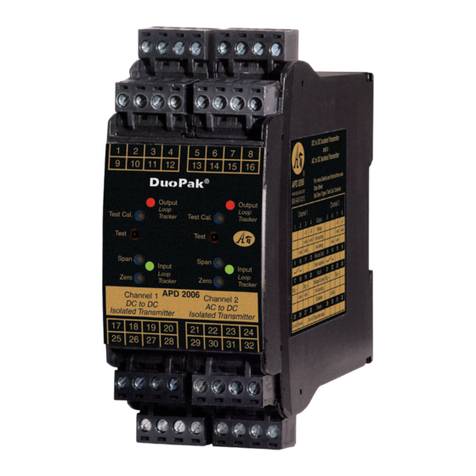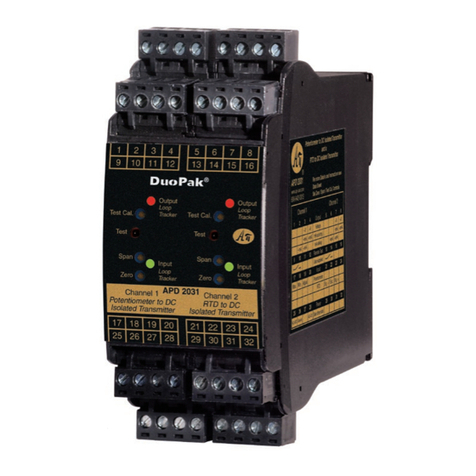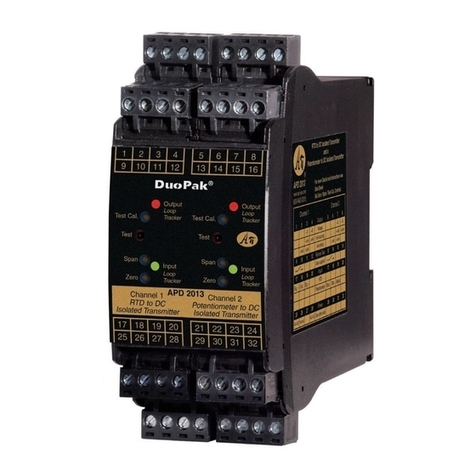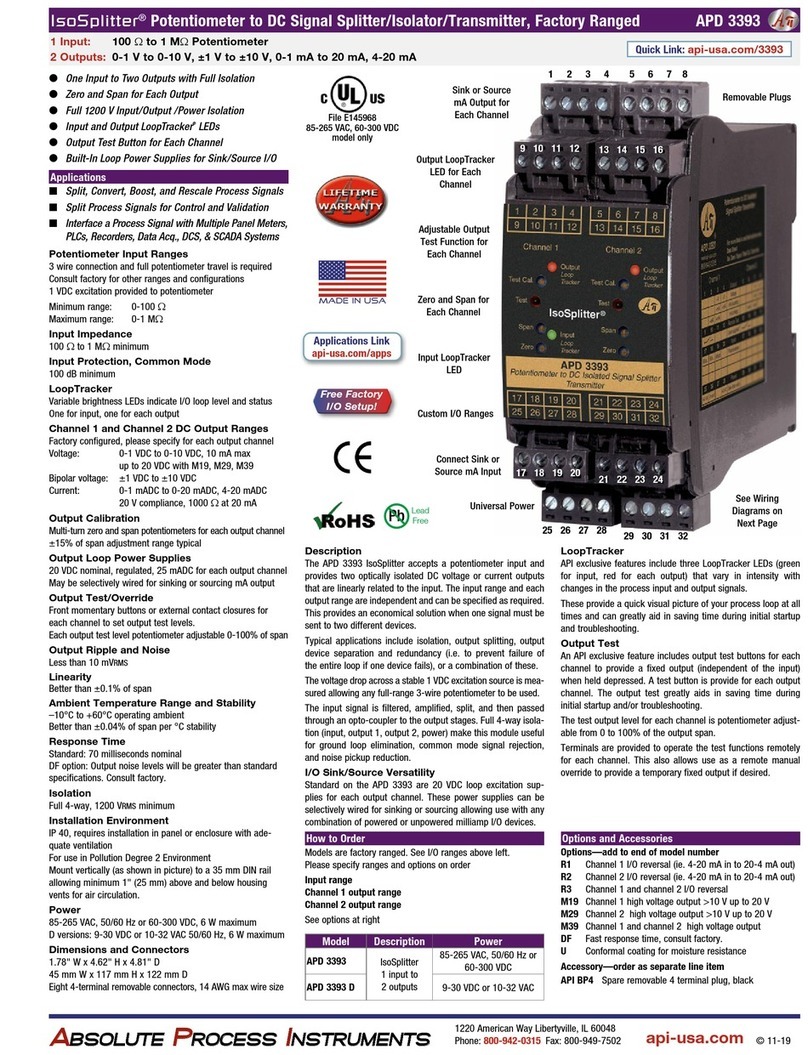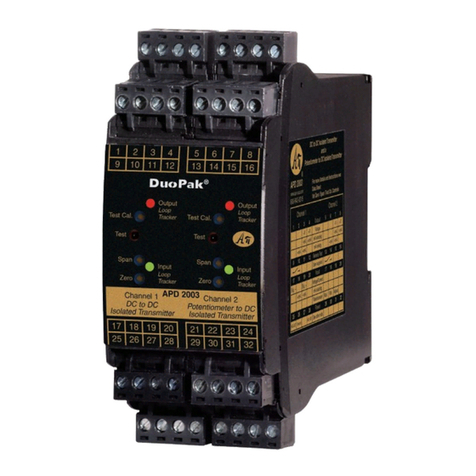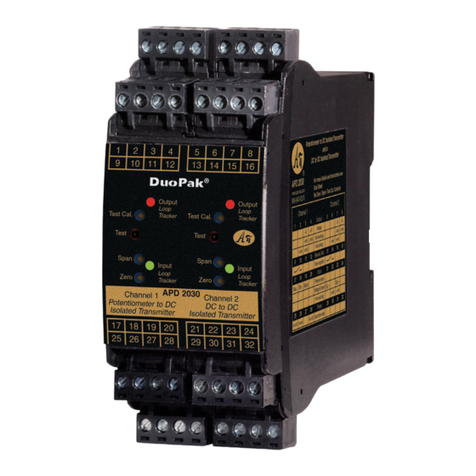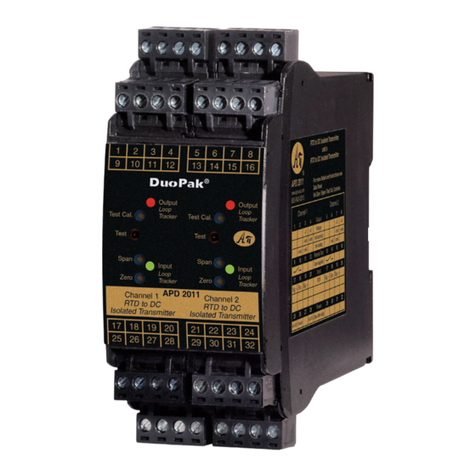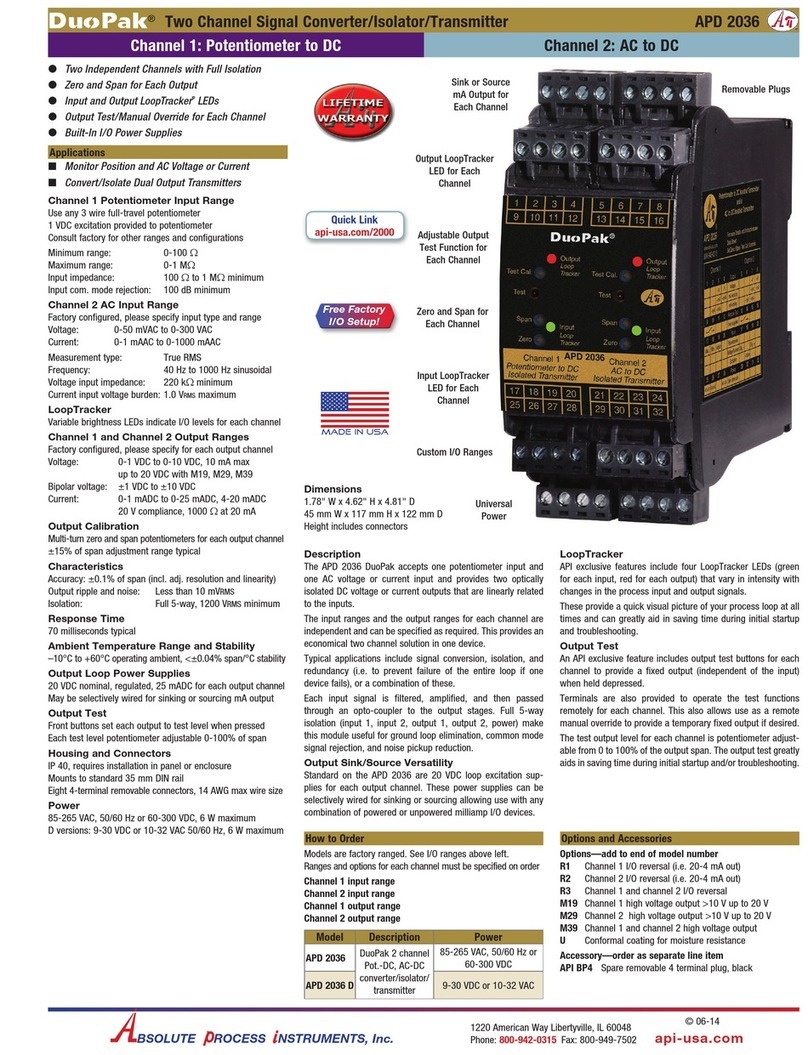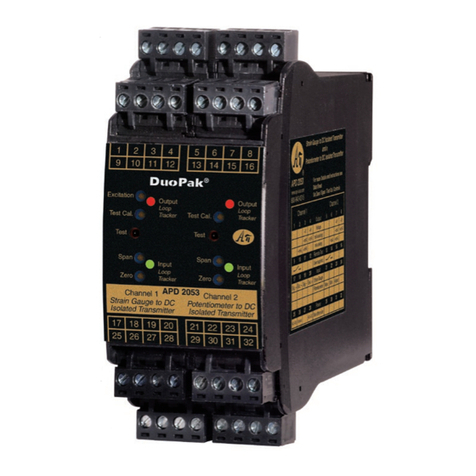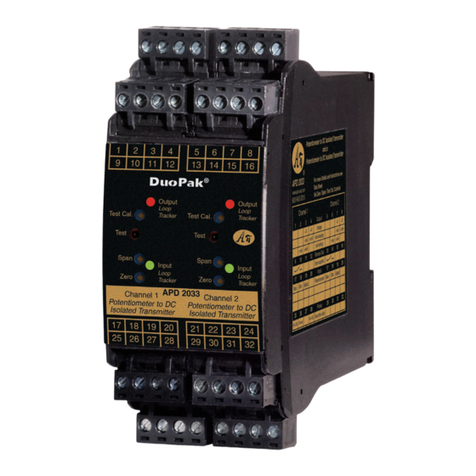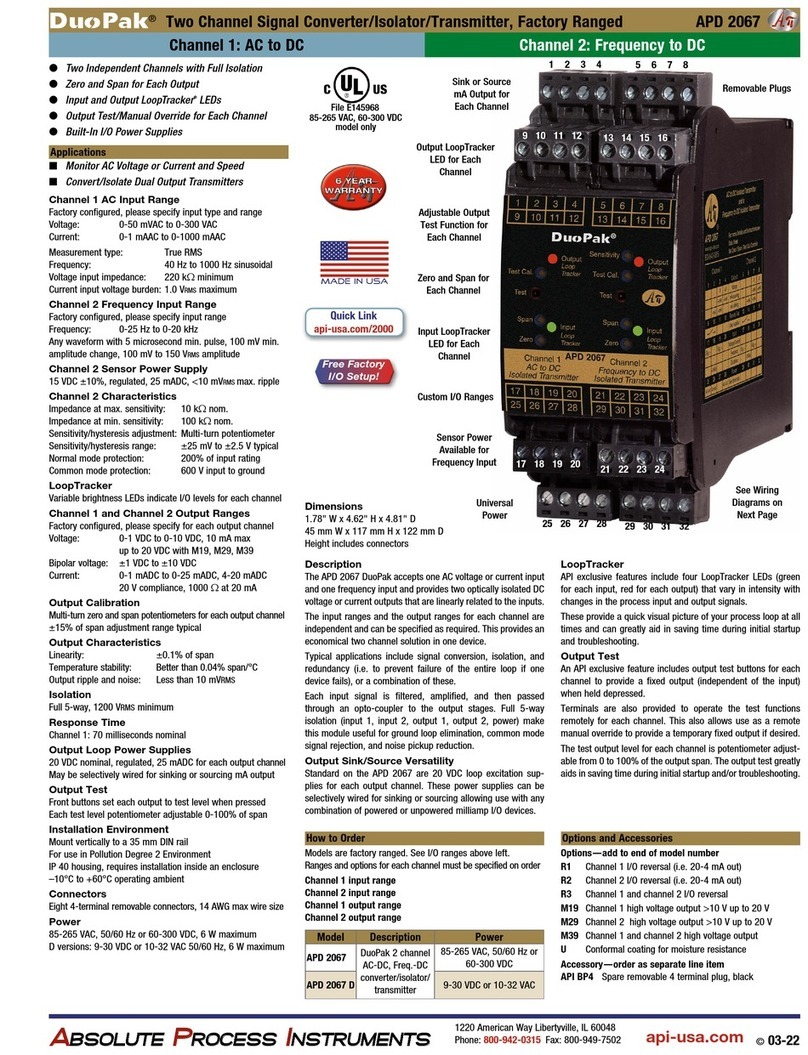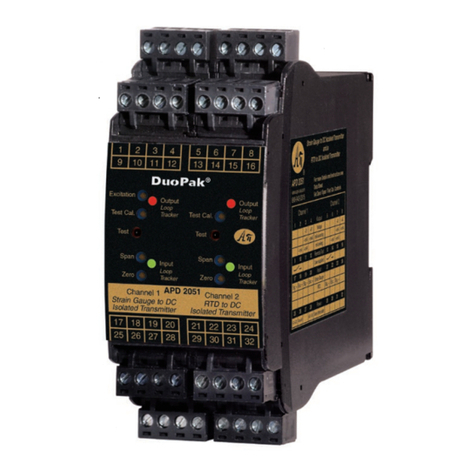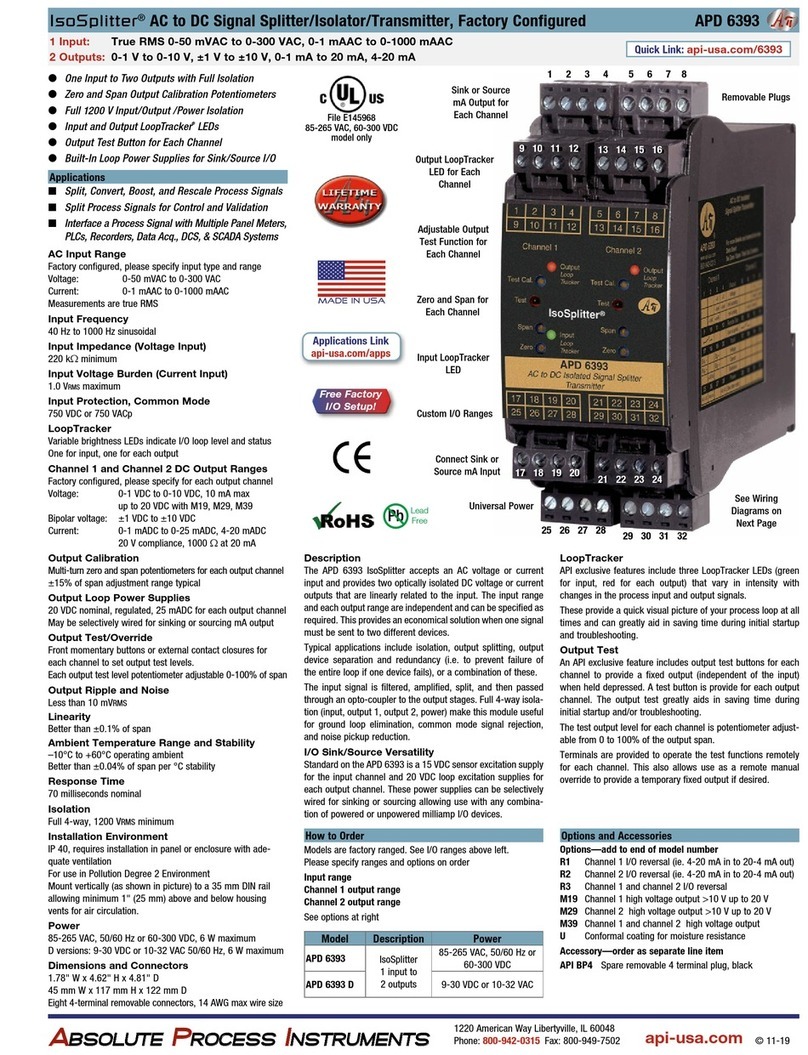
Removal
Avoid shock hazards! Turn signal input, output, and power off.
1. Push up on bottom back of module.
2. Tilt front of module downward to release upper mount from top
edge of DIN rail.
Output Calibration
Input and output ranges are factory pre-configured (at 24°C ±1°C).
Front-mounted Zero and Span potentiometers are used to calibrate
the output to compensate for load and lead variations.
1. Apply power to the module and allow a minimum 30 minute
warm up time. An accurate frequency calibration source such
as a signal generator may be required for calibration.
2. Provide an input to the module equal to the minimum input
required for the application, typically 0 Hz.
3. Using an accurate measurement device for the output, adjust
the Zero potentiometer for the exact minimum output desired.
The Zero control should only be adjusted when the input signal
is at its minimum. This will produce the corresponding minimum
output signal. For example: 4 mA for a 4-20 mA output or –10 V
for a ±10V output.
4. Set the frequency to the maximum required for the application. Using
an accurate measurement device for the output, adjust the Span pot
for the exact maximum output desired. The Span control should only
be adjusted when the input signal is at its maximum. This will pro-
duce the corresponding maximum output signal. Example: for 4-20
mA output signal, set the Span control for a 20 mA output.
5. Repeat adjustments for both output channels for maximum accuracy.
Sensitivity Adjustment
This multi-turn potentiometer provides an adjustable threshold
level that the incoming signal must overcome before an output can
be produced. This is used to limit noise and minimize false input
signals that may cause erroneous readings.
Fully clockwise: (max. sensitivity), input threshold is ±25 mV.
Fully counterclockwise: (min. sensitivity), input threshold is ±2.5 volts.
Output Test Function
When a Test button is depressed it will drive the output with a known
good signal that can be used as a diagnostic aid during initial start-up
or troubleshooting. When released, the output will return to normal.
Each Test Cal. potentiometer can be adjusted to set the test output from
0 to 100% of the output span. Press and hold the Test button and adjust
the corresponding Test Cal. potentiometer for the desired output level.
They may optionally be externally wired for remote test operation or
a manual override. See wiring diagram at right.
Operation
The APD 7393 IsoSplitter® accepts a frequency input and provides
two optically isolated DC voltage or current analog outputs that are
linearly proportional to the input.
The frequency input is capacitively coupled (to remove any DC
component at the input) to a comparator whose threshold is deter-
mined by the setting of the sensitivity control. The output from the
comparator passes through an opto-coupler to the output stage.
The green LoopTracker®input LED provides a visual indication that
the signal is being sensed by the input circuitry of the module. It
also indicates the input signal strength by changing in intensity as
the process changes from minimum to maximum.
If the LED fails to illuminate, or fails to change in intensity as the
process changes, check the module power or signal input wiring.
Two red LoopTracker output LEDs provide a visual indication that the
output signals are functioning. They become brighter as the input
and each corresponding output change from minimum to maximum.
For a current output the red LED will only light if the output loop
current path is complete. For either current or voltage outputs,
failure to illuminate or a failure to change in intensity as the process
changes may indicate a problem with the module power or signal
output wiring. Note that it may be difficult to see the LEDs under
bright lighting conditions.
Instructions APD 7393
1413 15 16109 11 12
External
Contacts
for Test
Function
– + 20V – + 20V
mA
Device 2
Ri
mA
Device 1
Ri
65 7 821 3 4
*Current
Sourcing
Output
Ch. 1 Ch. 2
Voltage
Output
– +
Voltage
Device 1
– +
Voltage
Device 2
21 3 4
Ch. 1 Ch. 2
65 7 8
– +
mA
Device 2
Ri
Loop
Power
Source 2
– +
+–
mA
Device 1
Ri
Loop
Power
Source 1
*Current
Sinking
Output
Ch. 1 Ch. 2
21346578
+–
28 Power AC or DC –
26 Earth Ground
25 Power AC or DC +
2625 27 28
To maintain
full isolation
avoid com-
bining power
supplies in
common with
inputs, out-
puts, or unit
power.
2 wire self-generating
2 Wire
1817 19 20
–Signal
Precautions
WARNING! All wiring must be performed by a qualified electrician
or instrumentation engineer. See diagram for terminal designations
and wiring examples. Consult factory for assistance.
WARNING! Avoid shock hazards! Turn signal input, output, and
power off before connecting or disconnecting wiring, or removing
or installing module.
Précautions
ATTENTION! Tout le câblage doit être effectué par un électricien
ou ingénieur en instrumentation qualifié. Voir le diagramme pour
désignations des bornes et des exemples de câblage. Consulter
l'usine pour assistance.
ATTENTION! Éviter les risques de choc! Fermez le signal d'entrée, le
signal de sortie et l'alimentation électrique avant de connecter ou de
déconnecter le câblage, ou de retirer ou d'installer le module.
Electrical Connections
See wiring diagrams at right. Observe polarity. If the output does
not function, check wiring and polarity.
*Do not make any connections to unused terminals or use them
as wiring junctions for external devices. This may cause permanent
damage to the module!
Outputs
Each product is factor configured to your exact ranges as indicated
on the serial number label. Polarity must be observed for signal
wiring connections. If the input and/or output do not function, check
wiring and polarity.
For milliamp output ranges determine if your devices provide power
to the current loop or if the loop must be powered by the APD mod-
ule. Typical voltage may be 9-24 VDC at your device's terminals if it
provides power to the loop.
Input
The input range is pre-configured at the factory. No input calibration
is necessary. The frequency input is compatible with most types of
sensors that product a minimum 100 mV amplitude change and a
minimum 5 microsecond pulse width. A 15 VDC supply is available to
power the sensor if required. Always refer to the sensor manufacturer's
data sheet to determine supply voltage compatibility and proper wiring.
Sensor Load
The frequency signal input is capacitively coupled to prevent any DC
in the input. Some sensors, typically those without an internal load
resistor, require a resistive load in order to function.
The resistor value may be specified by the sensor manufacturer
as the "minimum resistive load" or calculated from the sensor
manufacturer's specified "load current range".
The 15 VDC power supply is capable of providing 25 mA. A load
current range of 3 mA to 25 mA would typically use a 5 kWto
500 Wresistor.
Module Power
Check label for module operating voltage to make sure it matches
available power. The power supplies are fuse protected and the unit
may be returned to API for fuse replacement.
Either polarity is acceptable for DC power, but
for consistency, wire positive (+) to terminal
25 and negative (–) to terminal 28.
Mounting to a DIN Rail
Install module vertically on a 35 mm
DIN rail in a protective enclosure
away from heat sources. Do not block
air flow. Allow 1" (25 mm) above and
below housing vents for air circulation.
1. Tilt front of module down and position
the lower spring clips against the bottom
edge of DIN rail.
2. Push front of module upward until upper
mount snaps into place.
Frequency Sensor Signal
Com.
Sensor
Power
Signal
Input
2 wire or Namur, externally powered n/a 18 (+15 V) 19 (+)
2 wire self generating (VR) 17 (–) n/a 19 (+)
3 wire PNP or NPN 17 (–) 18 (+15 V) 19 (+)
Device for Output Channel 1 Terminal Terminal
Voltage input device 3 (–) 4 (+)
Passive mA device. APD module powers loop. 3 (–) 4 (+20 V)
mA device that powers the current loop. 2 (–) 3 (+)
Device for Output Channel 2 Terminal Terminal
Voltage input device 7 (–) 8 (+)
Passive mA device. APD module powers loop. 7 (–) 8 (+20 V)
mA device that powers the current loop. 6 (–) 7 (+)
APD 7393
Frequency to DC Isolated Signal Splitter
Transmitter
Test Cal.
Span
Zero
Test
Output
Loop
Tracker
Test Cal.
Span
Zero
Test
Output
Input
Loop
Tracker
Loop
Tracker
Channel 1 Channel 2
Sensitivity
IsoSplitter®
2 wire using 15 V supply
See sensor specs. if
bleed resistor is required
2 Wire
1817 19 20
–Signal
15 kWtyp. bleed resistor
+15
VDC
1817 19 20
–Signal
PNP
+15
VDC
Load resistor
Three wire PNP
17 Common (–),
Blue or Black
18 Power (+15 VDC)
Brown or Red
19 Signal,
Black or White
Some sensors may require
a load resistor from 17 to 19
Load resistor
NPN
1817 19 20
–Signal
+15
VDC
Three wire NPN
17 Common (–),
Blue or Black
18 Power (+15 VDC)
Brown or Red
19 Signal,
Black or White
Some sensors may require a
load resistor from 18 to 19
Spring Clips
Upper Mount
Cu 60/75°C conductors
14 AWG max.
api-usa.com
1220 American Way Libertyville, IL 60048
Phone: 800-942-0315 Fax: 800-949-7502
AABSOLUTEBSOLUTE PPROCESSROCESS IINSTRUMENTSNSTRUMENTS
25 26 27 28 not used
12 3 42 3 4 56 7 86 7 8
17 18 19 20
Input
Output 1 Output 2
Power
9 10 11 12 13 14 15 16
not used
25 26 27 28
not used
Output Test 1 Output Test 2Output Test 1 Output Test 2
Wire terminal
torque
0.5 to 0.6 Nm or
4.4 to 5.3 in-lbs
API maintains a constant effort to upgrade and improve its products.
Specifications are subject to change without notice. See api-usa.com for
latest product information. Consult factory for your specific requirements.
WARNING: This product can expose you to chemicals includ-
ing nickel, which are known to the State of California to cause
cancer or birth defects or other reproductive harm. For more
information go to www.P65Warnings.ca.gov
Module
powers mA
output loop
Module mA
output is
unpowered
mA output: determine if receiving device has a passive or powered
input. The module can be wired for a sinking or sourcing mA output.
* To avoid damage to the module, do not leave any unused
mA outputs disconnected. Use a 1000 Ohm 1/2 Watt resis-
tor across unused mA terminals.
* Do
not make
connections
to unused
terminals!
* Do not make
connections to
unused terminals!
